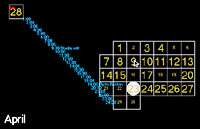T
R
A
N
S
C
R
I
P
T
2
3
4
5
6
7
8
9
10
11
12

|
T R A N S C R I P T |
1
2 3 4 5 6 7 8 9 10 11 12 |
 |
|
On the other hand, I do think that we experience apprehension when
operations are found to involve a destructive capacity. In terms of the
digital matrix, it is possible to change the symbolic information
contained in one of its slots with another symbol without retaining any
history of such an exchange. In terms of something we do everyday, like
communicate through E-mail, it is possible to erase or overwrite one's
correspondence without the hope of retrieving it. No doubt many of us
here have tried in vain to rescue from oblivion with some "unerasing" tool
a file mistakenly erased.
 Calendar As it was pointed out in one of the questions at my talk, the Internet today actually duplicates our information so that if we lose one version, another version may be archived and retrieved from another part of the system. This is true. But it is also the case that this archival system of backups is organized to discriminate, and I use this word in several senses. What is archivable is such because it is programmed or determined as such. Furthermore, any future reading of such an archive will be technologically determined in a way radically different from the archeological procedures we use on collections of letters and books, even when these are written in yet undeciphered scripts. We know we must rely on computer mechanism for future retrieval rather than rely on our unaugmented senses. This particular aspect of the digital archive is one with which we might feel uncomfortable, specially as it suggests a rethinking of the nature of memory.
|
|
But what does this have to do with how we experience digital
representations? Well, quite a bit and very little. Most of these
processes for which I have been trying to find a proper articulation
occur at sizes and speeds whose scales are quite divorced from our sense
of experience. In the course of experiencing digital representation most
of us will not be concerned with the status of each bit, let alone
remember it. It is here that the "experience" of digital representation
needs to be explored further. |
|
|
back | next Page: 1 | 2 | 3 | 4 | 5 | 6 | 7 | 8 | 9 | 10 | 11 | 12 |